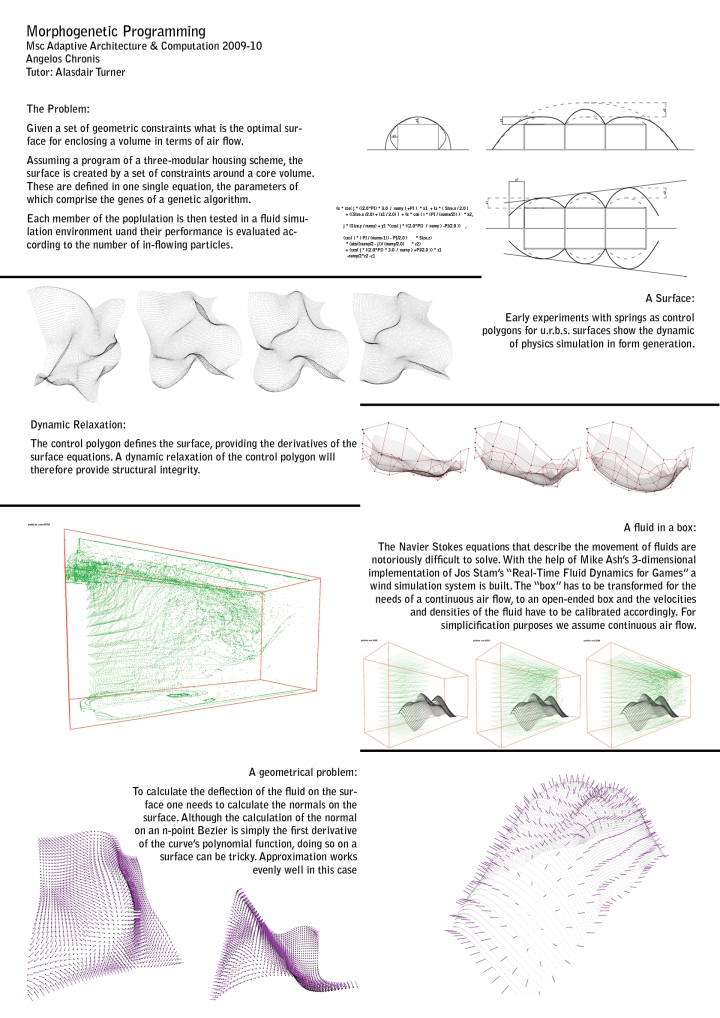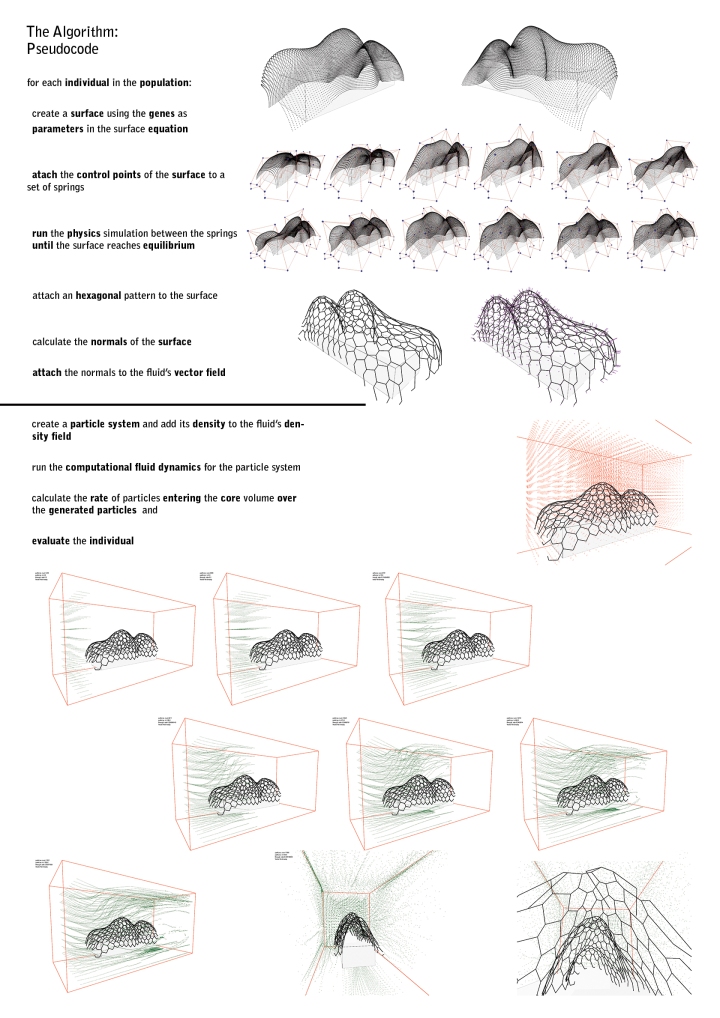C.F.D. C.G.I.
Presented at the ACADIA 2012 conference, in a paper, entitled Design Systems, Ecology and Time (last post), probably the best computer generated imagery I have produced using computational fluid dynamics. An attempt to model a von Kármán vortex street.
ACADIA 2012 – Design Systems, Ecology and Time
A paper entitled ‘Design Systems, Ecology and Time’, co-authored by Martha Tsigkari, Adam Davis, Francis Aish and myself was presented at the ACADIA 2012 conference – Synthetic Digital Ecologies, on the 20th of October in San Francisco. Link to the CUMINCAD to follow.
Abstract
Discussion of architecture in ecological terms usually focuses on the spatial and material dimensions of design practice. Yet there is an equally critical temporal dimension in ecology that is just as relevant to design. At the micro scale is the question of ‘real time’ feedback from our design systems. At the macro scale is the issue of sustainability, in other words long term — and potentially disastrous — feedback from terrestrial ecosystems. In between are numerous different units for quantizing time in design and computation. In this paper, we examine some of these units — ‘real time’, ‘design time’, ‘development time’ — to suggest how they interact with the ecology of design technology and practice. We contextualize this discussion by reference to relevant literature from the field of ecology and to our work applying custom design and analysis tools on architectural projects within a large interdisciplinary design practice.
SimAUD 2012 – Symposium on Simulation for Architecture and Urban Design
A paper entitled ‘Performance Driven Design and Simulation Interfaces: A Multi-Objective Parametric Optimization Process’ and co-authored by Martha Tsigkari, Evangelos Giouvanos, Francis Aish, Anis Abou-Zaki and myself was presented at the 3rd Symposium on Simulation for Architecture and Urban Design (SimAUD 2012) on the 27th of March 2012. The proceedings are freely available online here.
Abstract
Despite the continuous development and integration of simulation interfacing tools in current architectural research, the availability and operability of off-the-shelftools has still not met the timeframes and performance requirements of current architectural practice. The complexity anddemanding performance goals of contemporary large-scale projects often require innovative approaches, as well as the development of novel simulation interfacing toolsto meet theserequirements.
This paper reports on a multi-objective optimization process, aiming at reducing incident solar radiations whilst optimizingdaylight penetration, for the façade of a large-scale office building. This was achieved throughthe combined use of a parametric modeland a genetic algorithm,along with an integrated data set of pre-computed results. To minimize the resources demand of analyzing the plethora of potential configurations of the façade, a number of strategically defined modular caseswere modeled and simulated using bespoke interfacing tools to produce adatabase of results.This database wasthen linked to aparametric model, providing real time feedbackand allowingfor an exhaustive search of design configurations.To further explore potential optimal solutions, amulti-objective optimization process using a genetic algorithm,also linked to the results database, was implemented. The overall optimization process provided invaluable insight to the design problem at hand.
Respecting Fragile Spaces – 29th eCAADe Conference
During the Embedded and Embodied Technologies module of the AAC course our group (Valina Siskou, Prarthana Jagannath, Jonathan Jones and me) investigated the potential use of Bluetooth collected data to identify patterns of human flow and activity in the City of Bath.
The outcome of this study was presented in the 29th eCAADe conference in Ljubljana on 21-24 of September. The paper is available online through cumincad and the presentation is also available online.
Abstract
The impact of ubiquitous digital technologies on the analysis and synthesis of our
urban environment is undoubtedly great. The urban topography is overlaid by an invisible, yet
very tangible digital topography that is increasingly affecting our urban life. As W. J. Mitchell
(Mitchell 2005) pointed out, the digital revolution has filled our world with “electronic
instruments of displacement” that “embed the virtual in the physical, and weave it seamlessly
into daily urban life”. The mobile phone, the most integrated mobile device is closely related
to the notion of a digital identity, our personal identity on this digital space. The Bluetooth
is the mainly used direct communication protocol between mobile phones today and in this
scope, each device has its own unique ID, its “MAC address”. This paper investigates the
potential use of recording and analysing Bluetooth enabled devices in the urban scale in
understanding the interrelation between the physical and the digital topographies.
SimAUD 2011 – Symposium on Simulation for Architecture and Urban Design
The outcome of my dissertation, with the invaluable help from my supervisor, Alasdair Turner my tutor, Martha Tsigkari as well as Sean Hanna and the rest of the AAC people was presented at the SimAUD 2011 conference,part of the 2011 Spring Simulation Conference (SpringSim’11) in Boston, USA and with great honour recieved an “Outstanding Paper Award“.
The conference proceedings are available online. Part of the presentation was the following video:
Abstract
The integration of simulation environments in generative, performance-driven form-finding methods is expected to enable an exploration into performative solutions of unprecedented complexity in architectural design problems. Computational fluid dynamics simulations have a wide range of applications in architecture, yet they are mainly applied at final design stages for evaluation and validation of design intentions, due to their computational and expertise requirements.
This paper investigates the potential of a fast fluid dynamics simulation scheme in a generative optimization process, through the use of a genetic algorithm, for wind loading optimization of a free form surface. A problem-specific optimization environment has been developed for experimentation. The optimization process has provided valuable insight on both the performance objectives and the representation of the problem. The manipulation of the parametric description of the problem has enabled control over the solution space highlighting the relation of the representation to the performance outcome of the problem.
Future Cities – 28th eCAADe Conference
A paper entitled “Parametric Approach to the Bioclimatic Design of a Student Housing Building in Patras, Greece” which was written by my former tutor (Katherine Liapi) and me will be presented on the 28th eCAADe Conference at ETH Zurich on the 16th of September.
The Conference’s theme this year is “Future Cities” and its program is now online. There are also some very interesting Workshops taking place covering different areas, from environemntal and parametric tools to urban design systems.
Morphogenetic Programming
The Morphogenetic Programming module was one of the most interesting modules in the course.
The concept of this project originates in my general academic interest, which is the study of the flow of air inside and around the buildings. More specifically, the project involves the use of a Genetic Algorithm, based on Alasdair Turner’s code, to optimize a building’ s envelope, in terms of air intake. The algorithmic process also involves a dynamic relaxation scheme for the envelope surface, as well as the use of real time fluid dynamics and it is described in detail on the presentation posters.
One of the main challenges was the implementation of the CFD engine in Processing which was done with the help of Mike Ash’ s “Fluid Simulation for Dummies“, and Jos Stam’s paper “Real-Time Fluid Dynamics for Games”.
A potential future development, as well as an initial intenion is the incorporation of weather data in the simulation process (wind direction, speed and temperature), in order to create a realistic virtual environment for the evaluation of the generative process.
The posters demonstrate the principal concepts, the algorithmic process (in pseudocode) and the final piece.
These two videos were extracted from Processing from the two relevant sketches used to produce the project.
The first one was developed as a prototype module of a “building system” which was then incorporated as the phenotype of the genetic algorithm, as shown in the second video.
My deepest thanks to my teacher, Alasdair Turner and my tutor, Przemek Jaworski
Digital Ecologies
The “Digital Ecologies” module was an experimentation on physical computing in relation to the adaptive behaviours of natural organisms and systems.
The “Reconfigurable Grid” was a project done in collaboration with Petros Kataras and Eleni Sotiriou and under the guidance of our teacher Ruairi Glynn and our tutor Marilena Skavara.
The concept was inspired by the Plasmodium (the vegetative state of Physarum Polycephalum) which reconfidures its morphology to optimize nutrient absorption. Similarlly a grid of nodes physically connected to each other reconfigures itself reacting to light levels of the environment, through a set of light sensors and servo motors attached to the nodes and a set of Arduino boards controlling them. A neural network aims to incorporate a learning process in the grid, which can learn optimal configurations according to light input.
A more detailed description on the poster.
A video showing the development of the physical installation.
3D CFD with Processing
A video of the three dimensional CFD and particles engine that I created with Processing for the “Morphogenetic Programming“ module. The implementation of the CFD was done with the help of MIke Ash’ s “Fluid Simulation for Dummies“, which is based on Jos Stam’s paper “Real-Time Fluid Dynamics for Games”.
The engine was used to simulate air flow around a building envelope which was later optimized using a genetic algorithm.
More to follow on this project…
NURBS and springs..
Early experiments for the “Morphogenetic Programming” project..
A NURBS surface derived by a set of control points which are attached to springs is creating visually interesting transformations..
This early experimentation led to a dynamic relaxation scheme later..
More to follow on this project..
The examples on which the code was based are the particle spring chain and the NURBS surface examples by our tutor, Alasdair Turner.





leave a comment